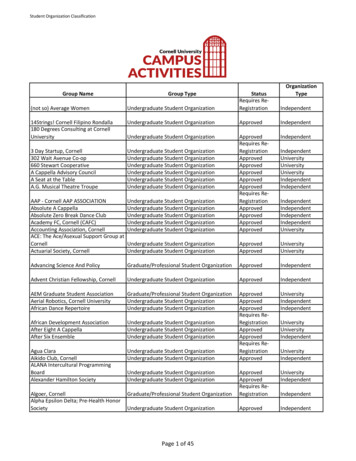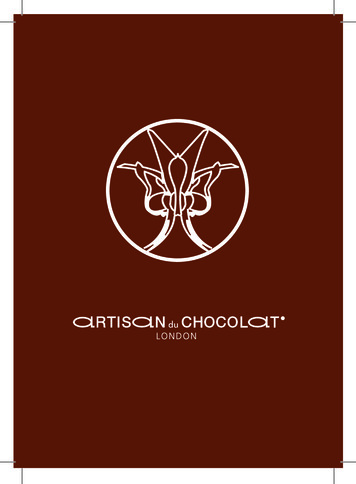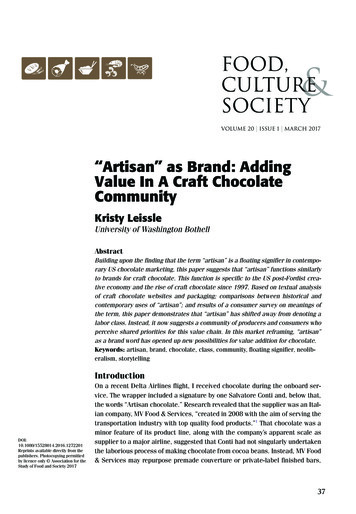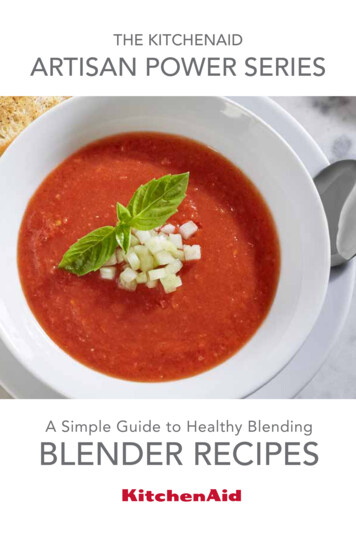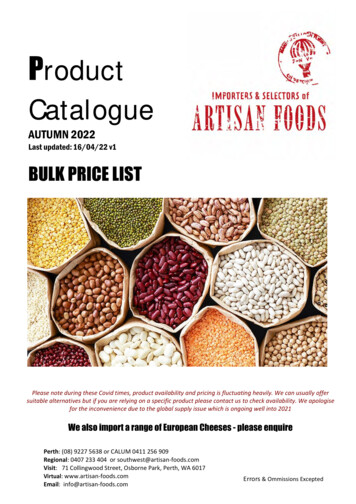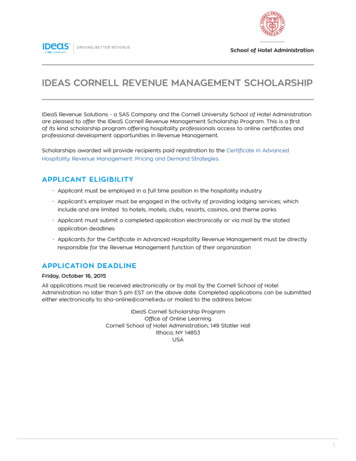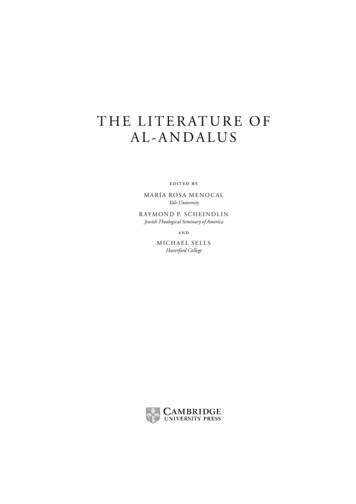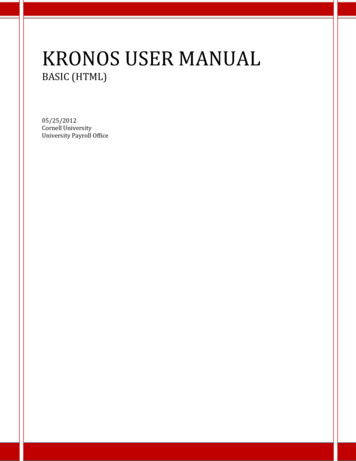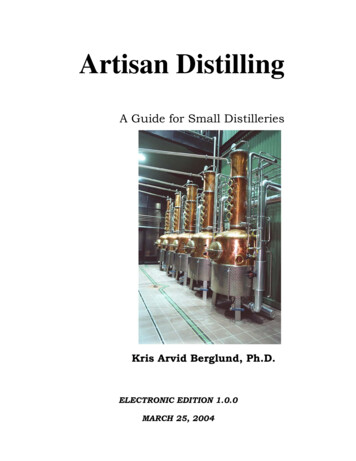
Transcription
Artisan DistillingA Guide for Small DistilleriesKris Arvid Berglund, Ph.D.ELECTRONIC EDITION 1.0.0MARCH 25, 2004
Artisan DistillingA Guide for Small DistilleriesKris Arvid Berglund, Ph.D.University Distinguished ProfessorDepartment of Chemical Engineering & Materials ScienceDepartment of Agricultural EngineeringMichigan State UniversityEast Lansing, MI 48824 USAberglund@msu.eduandProfessor and Division HeadDivision of Biochemical and Chemical Process EngineeringDepartment of Chemical Engineering and GeosciencesLuleå University of TechnologySE-971 87 Luleå, Swedenkris.berglund@ltu.seNotice: This book is provided free of charge for individual use byMichigan State University (MSU) and Luleå University of Technology(LTU). Any commercial use, reproduction for sale, or use in coursesthat charge a fee not offered in conjunction with MSU and LTU isstrictly prohibited without prior written authorization. All rightsreserved.
DedicationTo my wife Dianne, my son Erik, and my daughter Lisa, without yoursupport this book would not have been possible.
ForwardProduction of distilled spirits is certainly one of the oldest practicedbiotechnological processes. In recent years there has been rapid increasein interest in the production of spirits at smaller, artisan scale in theU.S. and other countries. This type of distillation is widely known andpracticed in the French and German speaking countries of Europe, butthere is a general lack of literature written in English. This work, whichdraws heavily from the widely popular book written in German by H.Tanner and H. R. Brunner, is aimed at filling this void. These authorsare thanked and acknowledged for their work. Dr. Klaus Weispfennigtranslated the Tanner and Brunner book into English which allowed itsuse as a reference. His efforts were invaluable since the author is notfluent in German and this book would not be possible without hisassistance.This book is aimed at the production of white spirits (fruit brandy/ eaude vie, vodka, gin, rum, etc.). While there is a large group of productsthat are stored in oak for color and flavor components, I do not attemptto cover the nuances of oak treatment for these products in any depth. Itshould be noted that all oak stored products start as white spirits, so theproduction of white spirits is common to the distilled beverage business.I have chosen to produce this book in electronic format. This choicekeeps the cost down and allows it to be kept current. I expect to becontinually updating it and welcome any comments or suggestions fornew or expanded topics.I would like to thank all the people who have helped me learn aboutsmall scale distillation, and in particular, Jörg Rupf of St. George Spiritsin Alameda, CA USA who help me start and continues to be a greatfriend and colleague; my good friends and colleagues at the variousartisan distilleries in Michigan and Sweden; and Alexander, Christian,and the entire Plank family of Christian Carl Ing. GmbH, Göppingen,Germany, who continue to be valued collaborators and friends.As we say in Sweden, skål!Kris Arvid BerglundLuleå, Sweden and East Lansing, MI USAMarch 2004
The author (KAB) in the foreground withformer MSU graduate student, Matt Berg, inthe background at the MSU distillery in EastLansing, MI USA. This 150 liter workingvolume still is a typical still used by theartisan distillers in Michigan.
RAW MATERIALSGeneral RequirementsAny sugar containing material can be the basis for the production ofspirits. Starch containing materials such as grains and potatoes arefermentable and are acceptable for whiskey, vodka, and gin production;however, in the U.S. they cannot be used for brandy production1. Thefollowing raw materials will be considered in the present work:For brandySeed fruit (apples, pears)Stone fruit (cherries, plums, apricots)Berry fruit (raspberries, currants, blackberries, juniper berries etc.)Pulp (grape and other fruit pulp)Seed fruit and grape wineYeast sediment productsRoots and tubers.For vodka, gin, whiskey:Grains (corn, wheat, barley, and rye)Roots (potatoes], not whiskeyFor rum:MolassesThe raw materials necessary for the production of excellent spirits needto meet certain quality demands, but the more common physical criteriafor table fruits such as color, shape, size and surface shine are lessimportant. It is the chemical composition of the fruit or grain which isdecisive for both a qualitative and quantitative satisfactory outcomeincluding:1. high sugar content2. strong developed, typical aroma (in fruits)3. clean, healthy, sound material (no mold or rot).In general, optimal sugar and aroma content can only be achievedthrough good ripening of the fruit or grain. Upon addition of sugar(forbidden by regulations in a wide number of countries in Europe andNorth America for brandy production) the lack of sugar content in unripefruit can be corrected: however, because of the lack in aroma theresulting brandy would likely be of poor quality. Moreover, the increasedlevel of tannin materials in unripe fruits can lead to fermentation hold-up1In the U.S., the controlling legisalation for production of distilled spirits. is the Code of FederalRegulations and lists the standards of identitiy for distilled spirits.
or faulty fermentations. Overly ripe fruit tends to rot and mold, whichresults in poor brandies. Furthermore, the fruits or grains used ought tobe free of any secondary odors and flavors (e.g. oils, sprays, pesticides,etc.) In summary, the condition of the raw material is of fundamentalimportance for the production of good spirits. Superior distillates cannot be obtained using low-grade material even with the most carefulprocessing.Distillation should never be considered a remedy forutilization of damaged or unsound fruit or grains.Table. 1: Sugar content and alcohol output of various raw materials (fromTanner and Brunner)Sugar content (%)Raw riesGentian rootsWindfalls (Seedfruit)Yeast 4-146-144-75-132-5795.5PomaceCherries, sweetPeachesPlumsQuincesMarcJuniper ums) Yield (liters of pure alcoholper 100 kg raw 64-92-46-187-126-154-82-45.55.55red 4.5black 46-84-1088-15104-86predominantly inulin
Components of the Raw MaterialsThe principalthree groups:components of fruits and grains can be classified into1. water2. solids/ insolubles3. soluble constituents.The water content of fresh fruit is normally between 80 and 85%while ingrains it is usually less than 20%. The solid, insoluble constituents suchas stems, shells, cores, stones and protopectin are less important fordistillation; they remain as residue in the still. Hexanol can be obtainedfrom the stem and leafs in the mash which can lead to undesirable leafyflavor. In practice it is necessary to remove, for example, the leaves andstems of cherries before marinating. The “cement substance” protopectinwill be decomposed during ripening or storage through enzymes(softening of fruits); also, the poisonous methyl alcohol (methanol) can beproduced through further decomposition of pectin. Care is to be takenwith stone fruit inasmuch not more than 5% of the stone are beingbroken in order to avoid an obtrusive bitter almond taste in the distillate.Water soluble substances are present in 10-20% in fruit and can becatergorized as carbohydrates, acids, proteins and nitrogen containingcompounds, phenolics, vitamins, aromatics, and minerals.Carbohydrates. Carbohydrates constitute the main part of the watersoluble fruit substances. The primary sweet tasting sugars are glucose(grape sugar), fructose (fruit sugar) and sucrose (cane and beet sugar).Glucose and fructose are monosaccharides (simple sugars) and arefermented by yeasts. However, sucrose (a disaccharide, i.e. a doublesugar) has to be decomposed first into glucose and fructose by means ofenzymes and/or acids in order to be fermentable. This process is calledinversion and proceeds during fermentation such that the residual sugarcontent of fermented musts and mashes is usually only glucose andfructose. The sum of glucose, fructose, and sucrose, i.e. the total sugarcontent, sets the potential alcohol yield. The yield can be calculatedbased on the fermentation equation:
C6H12O6 Sugar(Glucose, Fructose)2C2H5OHAlcohol(Ethyl Alcohol) 2CO2Carbon Dioxide(Fermentation Gas)Theoretically, 100 kg sugar (glucose, fructose) will yield approximately 51kg or 64.5 l alcohol. In practice, however, this number is actually notachieved, because the above equation is a simplified description of theactual processes.Less than theoretical yield is caused by sugarconsumption by the yeast, incomplete fermentation, the formation offermentation side products (e.g. fusel alcohols), and alcohol loss in thedistillation process. For these reasons a yield of only 56 liters of purealcohol per 100 kg glucose or fructose is generally realized in practice.Another carbohydrate present in fruits is the unfermentable sugaralcohol sorbitol. It is present in all seed and stone fruits whereas it ispractically absent in grapes, berry fruits and citrus fruits. Sorbitolcontent can be incorrectly interpreted as fermentable sugar in fermentedpomace fruit mashes and stone fruit mashes.Grains also possess fermentable sugars, but generally they are not in theform of simple sugars like those found in fruits. The predominant formof sugars in grains is starch. Starch is a polymer composed of repeatingunits of glucose; therefore, it is necessary to break the starch down tothe basic glucose unit for the yeast to convert the sugar into alcohol.This process is called hydrolysis and can be accomplished by use ofenzymes or acids.Acids. The taste of fruit is also determined by the content of non-volatileacids in addition to the sugars. During ripening, the sugar contentincreases at the expense of the acid content. However, fruit with an acidcontent too low (high sugar/acid ratio) not only affects the taste in anunsatisfactory way; but the resulting mashes are more susceptible tocontamination by undesired micro organisms which may lead to faultyfermentations. Mashes lower in acid, such as those made with Bartlettpears, should be fermented using pH adjustment by acid addition. Theprimary acids present in fruits are malic acid, citric acid, tartaric acid, and isocitric acid:HOOC-CH2-CH-COOH OHMalic AcidHOOC-CH2-C-CH2-COOH/\HO COOHCitric AcidHOOC-CH-CH-COOH OH OHTartaric AcidMalic acid is widely distributed in fruits, but is particularly present inseed fruit and in stone fruit. Citric acid is dominate in the majority ofberries and in citrus fruits whereas tartaric acid is present in a
significant concentrations only in grapes. Isocitric acid is found inblackberries, but in other fruits is only present in trace amounts.During primary fermentation and subsequent aging fruit acids aredecomposed through bacterial activity. In most cherry mashes thedecomposition of malic acid to lactic acid occurs without adverselychanging the mash. In the production of wine the conversion of the“hard” malic acid into the “softer” lactic acid is in sometimes desired anda secondary malo-lactic fermentation in undertaken intentionally. Thebacterial decomposition of citric acid leads to formation of lactic acid,acetic acid, formic acid, and acetaldehyde which can be detrimental tothe mash and can appear in the resulting distillate. Decompositionprocesses are associated with an increase of the pH which increases thesusceptibility of the mash to bacteria.Proteins and Nitrogen Containing Substances.In contrast tocarbohydrates and organic acids, proteins and their components, aminoacids, contain nitrogen. These compounds are important nutrients forthe fermentation as the yeast needs a nitrogen source for growth andmaintenance. If the nitrogen available to the yeast is not sufficient,fermentation hold-ups can occur and fermentation aids or nutrientsmust be used. In the wine industry this is sometimes referred as a“stuck” fermentation. The yeast fermentation is believed to convertcertain amino acids to the formation of aromas and flavors.An important nitrogen containing group is enzymes, which are proteinsthat catalyze or accelerate chemical processes in living organisms(metabolism) without being used up at the same time. They are effectivein small amounts and usually very specific for a reaction. Thus,complicated metabolic processes take place through the use of severalenzymes. As an example the enzyme system for alcoholic fermentationconsists of 12 different enzymes formed in the yeast cells. Every one ofthose enzymes participates in a specific reaction in the formation ofalcohol from glucose and fructose.Many enzyme-controlled reactions lead to undesired changes includingbrowning and oxidation reactions, increased methanol and cyanidecontents. Enzymes are heat sensitive like all proteins, a characteristicthat can be exploited for the reduction of their activity.Phenolics. This large group of compounds is often described by thegeneric name “tanning agents”. It contains plant colors as well ascombinations which condense to larger molecules and can cause thewell-known harsh and astringent taste. For elevated contents of phenolicsubstances the danger of fermentation hold-ups exists becauseflocculations/ precipitates are formed through deposition onto proteinsubstances
VitaminsAscorbic acid (vitamin C) is a major vitamin present in fruits,but does not, however, have great importance in fermentation. Contactwith oxygen in the air oxidizes vitamin C and converts it todehydroascorbic acid.The aroma of fruit is composed of a multitude of various substances. Forexample, in grapes the existence of more than 200 aromatic substancescould be demonstrated even though their total share is mostly under 0.1%. Aroma components are predominantly alcohols, volatile acids, esters,aldehydes, acetals, and ketones which form during both ripening,fermentation, and distillation. Many factors influence the aroma in thefresh fruit like geographical location, climate, and storage conditions.Some aroma agents, e.g. isoamyl alcohol from the amino acid leucine,form in the course of the fermentation, whereas others present in thefresh fruit are partly converted into different ones. This leads to the factthat the aroma of a fermented mash (fermentation bouquet) mat differgreatly from the corresponding fruit bouquet. The distillation of themashes as well as the subsequent storage of the distillates leads tofurther changes of the bouquet.Minerals. All fruits and grains contain minerals like potassium,calcium, magnesium, iron, phosphorus etc., which also serve asnutrients for the yeast. Fermentation hold-ups caused by excess mineralcontents are not common.Raw MaterialsSeed Fruit.Generally, surplus apples and pears are used for processing. Butspecialties from pure types of fruit are also produced. A well-knownapple variety is “Golden Delicious” and the pear variety is “Bartlett”, alsoknown as “Williams” in Germany. Pear brandy has one of the mostcharacteristic flavor and aroma of the original fruit of any of the fruitbrandies.The sugar content of seed fruit generally fluctuates very strongly (cf.Table 1), but has a mean of about 9-10 % both for apples and pears.Pears contain less acid than apples which causes them to be moresusceptible for infections; therefore, acid adjustment is generallyrequired. Must pears often contain a high level of tanning agent. Ingeneral, healthy seed fruit is stored for a while before use (decompositionof the tanning agent, softening of the fruit, aroma development), whereasdamaged raw materials have to be processed fairly soon because of riskof infection. Several processing possibilities exist:1. Mashing after preceding mincing (healthy fruit)
2. Fruit pressing and fast fermentation (foul, unripe fruit; hail damagedfruit; surplus use)3. Usage of overaged fruit wines (consider total SO2-content, as highsulfur content can leave to very poor distillates).Stone FruitsCherries which are richer in sugar and in aroma than table cherries aredesired for the production of cherry brandy (Kirsch). Early harvestedfruit generally does not have full sugar and flavor development; therefore,it is recommended to use fully ripe and even overly ripe fruit. Tartcherries often possess a higher (the taste being masked by the acid)sugar content than sweet cherries, but they can low in aroma.Experience with the Montmorency tart variety in Michigan has shownthat an excellent distillate can be produced from this variety.Cherries usually contain 20-40 g sorbitol/kg, a non-fermentable, sweettasting sugar alcohol.In case of faulty fermentations the nonfermentable sugar alcohol mannitol can also be formed from fructosesuch that refractometer measurements can wrongly indicate fermentablesugar. The stone content is approximately 10% of the total weight. Thecherries should be picked without stems and leaves should be removed.Cracked fruit needs to be processed immediately.Plums are more round in contrast to the longish ‘Zwetschgen’; their fleshis moreover softer and is less easily to separate from the stone. Sugarand acid content are rather somewhat lower compared to ‘Zwetschgen’and the aroma is - except of some special sorts - less developed. Plumsare more susceptible for decay than ‘Zwetschgen’ since their skin isthinner and thus easily crack and become rotten faster because of theirlower acid content. It is not uncommon to obtain impure distillates butwith proper processing (e.g. addition of acid to the mashes) it is possibleto obtain satisfactory results.Apricots are also an excellent raw material for distillate production. Theprocessing and treatment should generally follow the guidelines set outthe other stone fruit mentioned above.BerriesBerries are not as widely used for distillation as compared to stone fruitor seed fruit. Cultivated berries possess a relatively low sugar content of4-8% (exceptions: Grape and rose hip) as compared to wild growing ones.This low sugar content results in relatively low yield of distillate andsubsequently makes the raw material cost quite high. Berries are morewidely used for the production of liqueurs.
Raspberries, blackberries, and currants are the most widely used rawmaterials for distillate production. Cranberries and elderberries are richin tanning material and partially low on nitrogen; therefore,supplementation using fermentation aids should be used to avoidfermentation hold-ups. Juniper berries are commonly used in driedcondition, their sugar content is around an average of 20%. Due to thehigh content of tanning agents and resins it is difficult to ferment junipermashes.PulpMarc is the residual from the pressing of the fruit. Its sugar contentdepends to a great extent on the moment of the pressing as well as theassociated conditions in addition to the quality of the base material.White grapes are pressed while sweet and the resulting sugar content ofthe marc is thus higher than for red grapes which are pressed duringdecreasing fermentation in order to gain the color. In some cases thesugar content can be so low that the use of the marc is no longerprofitable for distillation raw material. Heating of the mash can increasethe sugar content for the marc of red grapes. The press conditions have asignificant influence on the sugar content: higher pressure, renewedloosening and pressing, hot pressing etc. are factors which contribute tothe juice yield; however, improved juice yield results in lower sugarcontent in the marc.Marc is highly perishable and should be processed quickly afterproduction. Increased contact with air can be avoided through a goodpulping.It is recommended to avoid the usage of marc alreadycontaining compounds that result in poor quality (e.g. marc with butyricacid tinge or an aldehyde content which is too high), because therecovery of their distillates is associated with tremendous expenditure ornot anymore possible at all. While present day practices and regulationsoften prohibit it, previously residuals of sprays could be found in themarc, especially sulfur and organic sulfur constituents. During thecourse of the fermentation this sulfur is converted to hydrogen sulfidesuch that the odor of rotten eggs is formed. Marc mostly yields distillateswith increased aldehyde and methanol content. An important element toconsider in both marc and pomace use it that the sugar content isalways low relative to other feedstocks and there will always be a muchhigher concentration of flavor and aroma components in the finaldistillation process.The pulp of apples and pears (i.e. pomace) generally contains less sugarthan the marc of grapes and their processing is often not very profitable.Pomace distillates are also known for their relatively high methanolcontent. Methanol forms during the fermentation through the influenceof a fruit specific enzyme (pectin methyl esterase) from pectin present
mostly in large quantities in pears. High methanol contents can pose aproblem in the US as the allowable limits are lower and the regulationsare more closely enforced than in some other countries.WinesOften faulty wines or low-grade wines are used for distillation. Specialcare must be employed during distillation and the addition of specifictechnical measures (elimination of the sulfur compounds, lowering of anexcessive acetic acid content, etc.).Bitter wines and wines withmercaptan, butyric acid, or oil taste are unusable.The most well-known brandies made from wines are of French origin.The applelations “Cognac” or “Armagnac” are used exclusively for theproducts stemming from the wines of the particular growing areas.Moreover there are regulations regarding the distillation process andstorage in oak barrels. The designation “Wine brandy (i.e. brandy)”indicates a distillate from wine.Yeast Sediment ProductsLees and yeast sediment products can be used for distillates. It isrecommended for them to be collected in barrels, to fill the barrels to theneck, and to distill those raw materials as soon as possible. Prolongedwaiting periods should be avoided at all costs in order to avoid theformation of yeast decay products.Starch based materialsGrains (corn, barley, wheat, rye) and potatoes are widely used for theproduction of vodkas and whiskeys. Because all of these materialscontain high concentrations of starch, there is never a problem relative tothe amount of sugar available for fermentation. Rather, the problem isactually the opposite as compared to fruit fermentations. Yeast can onlyperform up to concentrations of alcohol of around 15% because of thetoxicity of alcohol on yeast; therefore, if the sugar source is too high, thesugar will be wasted because the yeast will not ferment it. This featureallows the separate optimization of the amount of grain or potatoes in agiven process.As mentioned previously, starch is a polymer of repeating glucose units;therefore, it is necessary to break down the starch into it componentglucose units prior to fermentation. This pretreatment will be discussedfurther in the following chapter.
MASHING AND FERMENTATIONMash and Fermentation ContainersMash and Fermentation Container Materials of ConstructionThe traditional oak barrel used as a mash and fermentation container isno longer used for distillate production even though it retains its role forthe preparation of wines and for the storage of certain distillates.Wooden barrels are very labor intensive with respect to startingoperations, cleaning and maintenance; also their storage in emptyconditions poses problems which include the establishment of undesiredmicro-organisms and undesired influences on the taste.A several materials are available as alternatives for the wooden barrel,including metal and plastic containers, concrete and stone materials,and glass. In comparison to the wooden barrel these materials possessadvantages with respect to cleaning, maintenance, and sealing. It shouldbe noted, though, that not all materials are suitable for the direct contactwith mashes and in such cases it is necessary to apply an interior liningof the container walls. Mashing and fermentation containers made ofhigh-grade stainless steel (high-chrome steel) are recommended withoutrestrictions, but lower grades of stainless steel may lead to problems ifusing gaseous SO2. Different restrictions apply for mild steel andaluminum. Since these materials are corroded by fruit acids, an interiorlining, made of plastic or glass enamel is required.Fiber-reinforced polyester resins and low-pressure polyethylene tanksare widely used due to their low weight and high corrosion resistance.Plastic containers can also be installed outdoors; however, ultravioletlight from the sun can cause significant degradation leaving tobrittleness and cracking. Models suitable for stacking are also available.No interior lining is necessary for the fermentation and storage of fruitmashes in plastic containers because such tanks are usually neutralwith respect to taste of the products. If in doubt this assertion should bechecked. In general, plastic tanks can be purchased with prior approvalfor food use by the FDA in the US and the supplier should be consulted.Glass and concrete also have importance as fermentation vessels. Thedirect contact of concrete by the mash should be avoided because fruitacids spall or corrode concrete. In such cases epoxy-resins can be usedas linings for concrete containers.Cleaning and Maintenance
Barrels and vats made of wood have to be sealed against leakage. Sealingis achieved by thorough soaking with water to sweel the wood and this isparticularly necessary if they have been empty for some time. The watershould be renewed every 1-2 days. However, it is not possible to achieveairtight wooden barrels and loss of alcohol has to be taken into accountwhen wood is used.The interior should be cleaned immediately after emptying to avoid theformation of dried mash crust. The barrel should be flushed thoroughlywith cold water and then brushed with a hot cleaning agent (e.g. 2%sodium solution). Afterwards the barrel needs to be flushed again withcold water until it drains clear and without any foreign taste. Care needsto be taken also of the exterior cleanliness. In particular, the formationof mold can be avoided through a periodical treatment of the exterior wallwith an impregnating salt or oil, but chlorine should be avoided.The barrels need to be dried after cleaning and empty containers shouldnever be closed. If they are not used for some time, a barrel conservationis required to protect against undesired microorganisms. A provenclassical method is the burning of a non-dripping sulfur bar according tothe size of the barrel or the filling with water containing sulfuric acid(500 ml 5% SO2/hl water). A 1-2 % solution of formalin serves the samepurpose. The effect of the sulfuric acid decreases with time such that theprocedure has to be renewed every 1-2 months. Before reuse the woodenbarrels should be carefully examined for their condition.The cleaning of containers not made of wood does not pose anydifficulties. The sequence: cold water - cleaning agent - cold water alsoapplies. In this case alkaline, acidic or chlorine-containing agents can beused and it is recommended to make sure the reagents are food grade. Itis not recommended to use these cleaning techniques for mild steel oraluminum without great care. In any case a thorough flushing withwater has to follow. The use of soft brushes is recommended for plasticmaterial and high-grade steel in order to maintain a smooth surface.Sealing of the Fermentation ContainersLids for containers of any size should prevent inflow of air becauseexternal air (containing oxygen) contact with the mash promotes theformation of undesired microorganisms, e.g. film-forming or aceticbacteria, while the yeast used for the fermentation of the sugar does notrequire any oxygen. A fermentation in an open container will inevitablyresult in an infection of the mash as well as alcohol losses. As it can beseen from the governing equation for the fermentation (in a followingsection) the most important side product of alcohol fermentation isgaseous carbon dioxide (CO2) which is produced in large quantities and
has to be released from the fermentation container . This venting ofcarbon dioxide is achieved through the use of an air lock as shown inFig. 1. The air lock is constructed in such a way that the barrier liquid(usually water) does not allow air inflow whereas the escape of the carbondioxide is possible because of the slight elevated pressure present insidethe vessel. The observance of gas bubbles moving through the air lockcan be used to follow the course of the fermentation. While pure water isoften used, a 1:1 solution of water and glycerin or, after completedfermentation, a 2% sulfuric acid can be used as barrier liquids ifevaporation is a problem.Figure 1: Air lockDesignation1 Bell2 Bottom Part3 Barrier Liquid4 Rubber Plug(from Tanner andBrunner)MASHING AND MASH TREATMENTMashing and Mash Treatment of FruitsThe individual steps at the beginning of the fermentation process play asan important role as the requirements regarding the raw materials whichshould be met to obtain flawless distillates. They all serve the purpose toprovide optimal conditions for the yeast to proceed with the fermentationprocess. The steps include: washing and crushing of the fruit and theaddition of acids, pectin-reducing enzymes and fermentation aides(fermentation salts, combined nutrient preparations for yeast).Ofcourse, not all those measures have the same importance regarding thedifferent kinds of fruit or grain. It is not possible to specify a general"correct" procedure for the mashing because too many factors
For vodka, gin, whiskey: Grains (corn, wheat, barley, and rye) Roots (potatoes], not whiskey For rum: Molasses The raw materials necessary for the production of excellent spirits need to meet certain quality demands, but the more common physical criteria for table fruits such as
